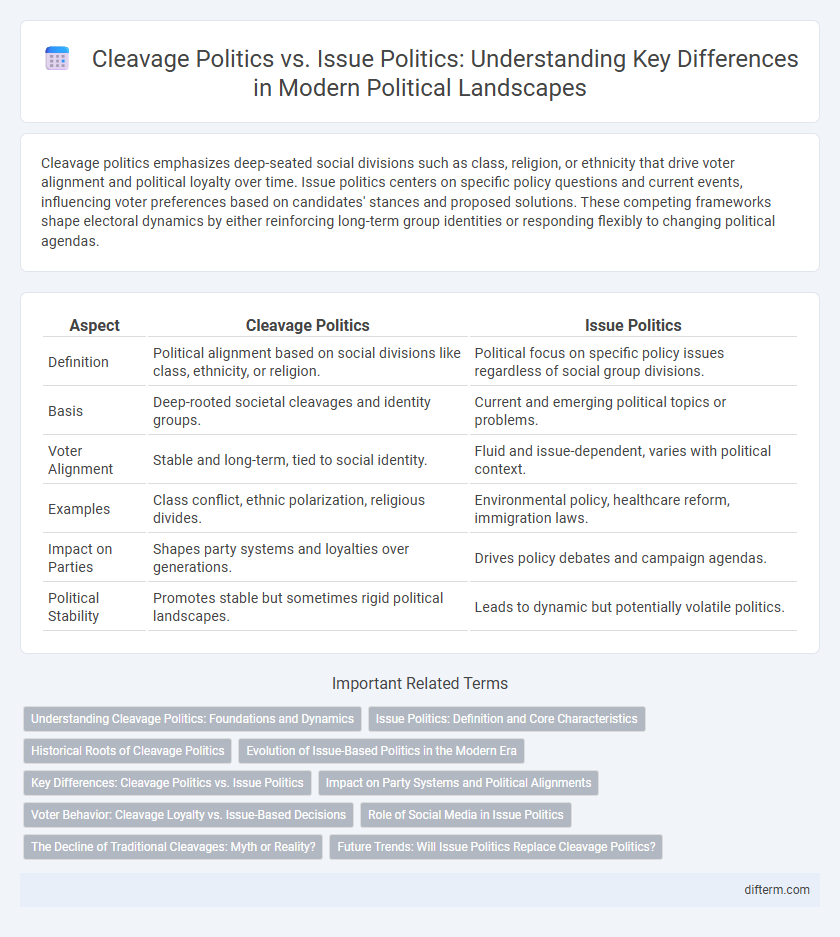Cleavage politics emphasizes deep-seated social divisions such as class, religion, or ethnicity that drive voter alignment and political loyalty over time. Issue politics centers on specific policy questions and current events, influencing voter preferences based on candidates' stances and proposed solutions. These competing frameworks shape electoral dynamics by either reinforcing long-term group identities or responding flexibly to changing political agendas.
Table of Comparison
| Aspect | Cleavage Politics | Issue Politics |
|---|---|---|
| Definition | Political alignment based on social divisions like class, ethnicity, or religion. | Political focus on specific policy issues regardless of social group divisions. |
| Basis | Deep-rooted societal cleavages and identity groups. | Current and emerging political topics or problems. |
| Voter Alignment | Stable and long-term, tied to social identity. | Fluid and issue-dependent, varies with political context. |
| Examples | Class conflict, ethnic polarization, religious divides. | Environmental policy, healthcare reform, immigration laws. |
| Impact on Parties | Shapes party systems and loyalties over generations. | Drives policy debates and campaign agendas. |
| Political Stability | Promotes stable but sometimes rigid political landscapes. | Leads to dynamic but potentially volatile politics. |
Understanding Cleavage Politics: Foundations and Dynamics
Cleavage politics centers on deep-rooted social divisions such as class, religion, and ethnicity that shape party systems and voter alignments over time. These enduring social cleavages create stable political identities that influence electoral behavior and policy preferences. Understanding the foundations of cleavage politics requires analyzing historical conflicts and societal structures that underlie persistent political divides.
Issue Politics: Definition and Core Characteristics
Issue politics centers on specific policy debates and societal concerns that transcend traditional party lines, emphasizing pragmatic solutions over ideological allegiance. This form of politics is marked by fluid voter alignments, where electoral decisions hinge on current issues such as healthcare, climate change, or economic reform. Unlike cleavage politics, which is rooted in deep-seated social divisions and identity groups, issue politics drives political engagement through evolving public priorities and policy-driven discourse.
Historical Roots of Cleavage Politics
Cleavage politics has deep historical roots in social divisions such as class, religion, and ethnicity, which shaped party systems and voter alignments since the 19th century. The Industrial Revolution and nation-state formation intensified these social cleavages, embedding enduring political identities. In contrast, issue politics emerged later, focusing on specific policy debates rather than entrenched social group divisions.
Evolution of Issue-Based Politics in the Modern Era
The evolution of issue-based politics in the modern era reflects a shift from traditional cleavage politics, which centered on social divisions like class, religion, and ethnicity, toward a focus on specific policy issues such as climate change, healthcare, and immigration. Political parties increasingly adopt platforms grounded in detailed policy proposals, responding to growing voter demand for tangible solutions rather than identity-based loyalties. This transformation is driven by factors including increased political awareness, media influence, and the diversification of political interests in contemporary democratic societies.
Key Differences: Cleavage Politics vs. Issue Politics
Cleavage politics centers on deep-rooted social divisions such as class, religion, or ethnicity that shape political identities and voting behavior over time. Issue politics, in contrast, revolves around specific policy debates or current events that influence political opinions temporarily. Key differences include the persistence of cleavage politics in maintaining long-term group loyalties, whereas issue politics tends to reflect shifting public concerns and can lead to changing political alignments.
Impact on Party Systems and Political Alignments
Cleavage politics, rooted in deep social divisions such as class, religion, or ethnicity, often results in rigid party alignments and stable party systems by reinforcing long-standing loyalties. Issue politics, centered on specific policy concerns like the environment or immigration, tends to induce fluidity in party systems by prompting voters to realign based on evolving priorities rather than entrenched identities. The interplay between cleavage and issue politics shapes the stability, fragmentation, and adaptability of political party systems in democratic societies.
Voter Behavior: Cleavage Loyalty vs. Issue-Based Decisions
Voter behavior often reveals distinct patterns between cleavage loyalty and issue-based decisions, where cleavage politics anchors voters to long-standing social divisions such as class, ethnicity, or religion, reinforcing party alignment over time. In contrast, issue politics drives voters to evaluate candidates and parties based on specific policy positions, leading to more fluid and situational voting choices. Research shows that younger and more politically aware electorates increasingly prioritize issue-based decisions, challenging traditional cleavage voting patterns.
Role of Social Media in Issue Politics
Social media platforms significantly amplify issue politics by enabling rapid dissemination and real-time engagement on policy-specific topics, fostering grassroots mobilization and public debate beyond traditional party lines. Unlike cleavage politics, which centers on entrenched social divisions such as class or religion, issue politics thrives on digital spaces where diverse perspectives converge and evolve dynamically. The role of social media in shaping voter awareness and influencing political agendas has become pivotal in contemporary democratic processes.
The Decline of Traditional Cleavages: Myth or Reality?
Traditional cleavages such as class, religion, and ethnicity have experienced a measurable decline in shaping voter behavior, yet their influence persists within specific socio-political contexts. Recent studies indicate that while many voters prioritize issue politics centered on policy preferences and values, underlying group identities continue to subtly guide political alignment. Empirical data from multiple democracies reveal that the decline of traditional cleavages is more nuanced, reflecting transformation rather than complete erosion.
Future Trends: Will Issue Politics Replace Cleavage Politics?
Issue politics is gaining prominence as voters increasingly prioritize policy solutions over traditional social divisions like class, ethnicity, or religion. Technological advancements in data analytics and social media amplify issue-based campaigning, enabling politicians to target specific concerns such as climate change, healthcare, and economic inequality. Future trends indicate a gradual shift toward issue politics, but entrenched cleavage-based loyalties continue to shape electoral behavior in many regions.
Cleavage politics vs Issue politics Infographic

 difterm.com
difterm.com